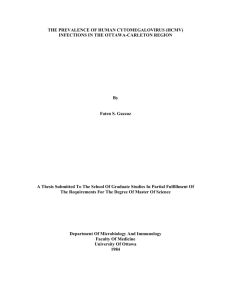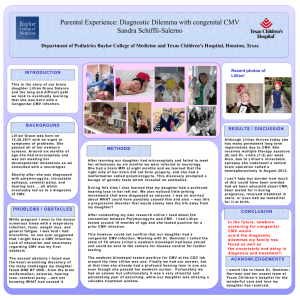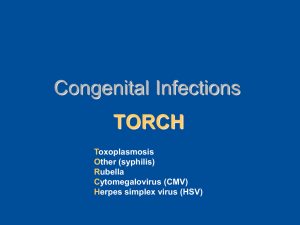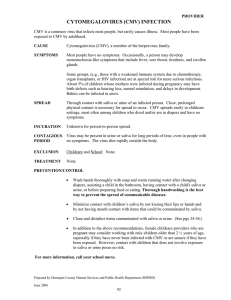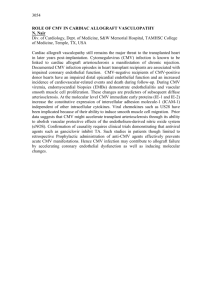Seroprevalence to cytomegalovirus in the
advertisement
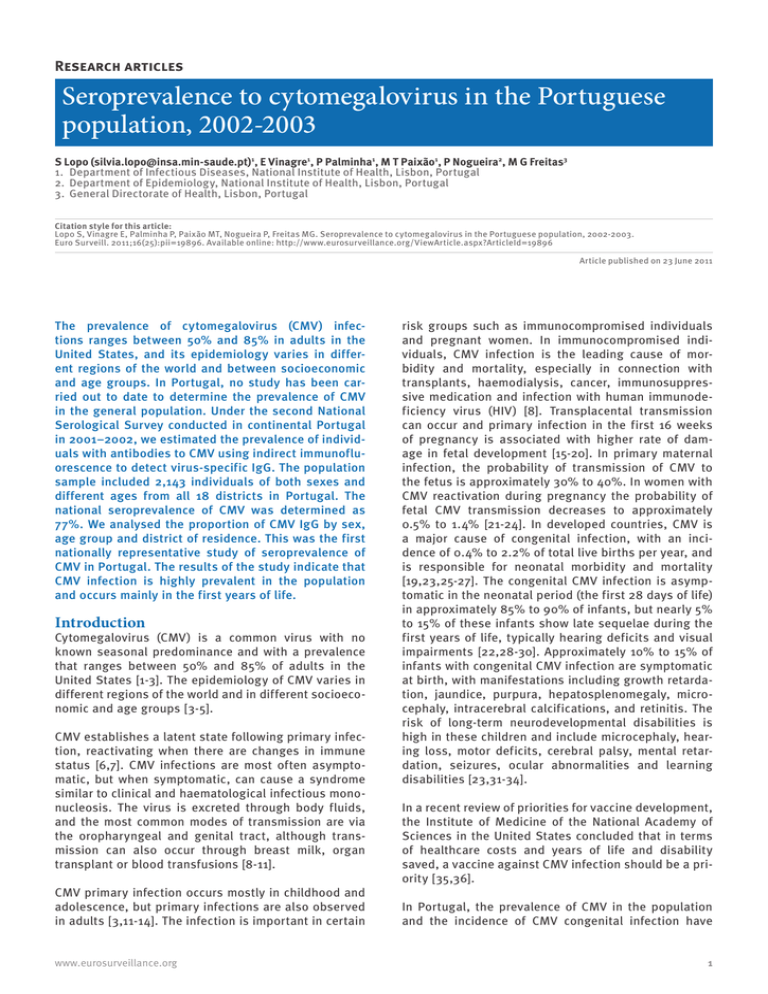
Research articles Seroprevalence to cytomegalovirus in the Portuguese population, 2002-2003 S Lopo (silvia.lopo@insa.min-saude.pt)1, E Vinagre1, P Palminha1, M T Paixão1, P Nogueira2, M G Freitas3 1. Department of Infectious Diseases, National Institute of Health, Lisbon, Portugal 2. Department of Epidemiology, National Institute of Health, Lisbon, Portugal 3. General Directorate of Health, Lisbon, Portugal Citation style for this article: Lopo S, Vinagre E, Palminha P, Paixão MT, Nogueira P, Freitas MG. Seroprevalence to cytomegalovirus in the Portuguese population, 2002-2003. Euro Surveill. 2011;16(25):pii=19896. Available online: http://www.eurosurveillance.org/ViewArticle.aspx?ArticleId=19896 Article published on 23 June 2011 The prevalence of cytomegalovirus (CMV) infections ranges between 50% and 85% in adults in the United States, and its epidemiology varies in different regions of the world and between socioeconomic and age groups. In Portugal, no study has been carried out to date to determine the prevalence of CMV in the general population. Under the second National Serological Survey conducted in continental Portugal in 2001–2002, we estimated the prevalence of individuals with antibodies to CMV using indirect immunofluorescence to detect virus-specific IgG. The population sample included 2,143 individuals of both sexes and different ages from all 18 districts in Portugal. The national seroprevalence of CMV was determined as 77%. We analysed the proportion of CMV IgG by sex, age group and district of residence. This was the first nationally representative study of seroprevalence of CMV in Portugal. The results of the study indicate that CMV infection is highly prevalent in the population and occurs mainly in the first years of life. Introduction Cytomegalovirus (CMV) is a common virus with no known seasonal predominance and with a prevalence that ranges between 50% and 85% of adults in the United States [1-3]. The epidemiology of CMV varies in different regions of the world and in different socioeconomic and age groups [3-5]. CMV establishes a latent state following primary infection, reactivating when there are changes in immune status [6,7]. CMV infections are most often asymptomatic, but when symptomatic, can cause a syndrome similar to clinical and haematological infectious mononucleosis. The virus is excreted through body fluids, and the most common modes of transmission are via the oropharyngeal and genital tract, although transmission can also occur through breast milk, organ transplant or blood transfusions [8-11]. CMV primary infection occurs mostly in childhood and adolescence, but primary infections are also observed in adults [3,11-14]. The infection is important in certain www.eurosurveillance.org risk groups such as immunocompromised individuals and pregnant women. In immunocompromised individuals, CMV infection is the leading cause of morbidity and mortality, especially in connection with transplants, haemodialysis, cancer, immunosuppressive medication and infection with human immunodeficiency virus (HIV) [8]. Transplacental transmission can occur and primary infection in the first 16 weeks of pregnancy is associated with higher rate of damage in fetal development [15-20]. In primary maternal infection, the probability of transmission of CMV to the fetus is approximately 30% to 40%. In women with CMV reactivation during pregnancy the probability of fetal CMV transmission decreases to approximately 0.5% to 1.4% [21-24]. In developed countries, CMV is a major cause of congenital infection, with an incidence of 0.4% to 2.2% of total live births per year, and is responsible for neonatal morbidity and mortality [19,23,25-27]. The congenital CMV infection is asymptomatic in the neonatal period (the first 28 days of life) in approximately 85% to 90% of infants, but nearly 5% to 15% of these infants show late sequelae during the first years of life, typically hearing deficits and visual impairments [22,28-30]. Approximately 10% to 15% of infants with congenital CMV infection are symptomatic at birth, with manifestations including growth retardation, jaundice, purpura, hepatosplenomegaly, microcephaly, intracerebral calcifications, and retinitis. The risk of long-term neurodevelopmental disabilities is high in these children and include microcephaly, hearing loss, motor deficits, cerebral palsy, mental retardation, seizures, ocular abnormalities and learning disabilities [23,31-34]. In a recent review of priorities for vaccine development, the Institute of Medicine of the National Academy of Sciences in the United States concluded that in terms of healthcare costs and years of life and disability saved, a vaccine against CMV infection should be a priority [35,36]. In Portugal, the prevalence of CMV in the population and the incidence of CMV congenital infection have 1 not previously been determined. However, in 2003, preliminary results of a prospective study indicated that the proportion of CMV congenital infections was 0.7% in a consecutive population of newborns in the area of Lisbon, as determined using the gold standard technique, shell vial culture of urine [37]. According to a survey by Paixão et al. [38] that screened for CMV congenital infection by PCR of blood samples obtained from Guthrie cards, the proportion of congenital infection by CMV was 1.1% in Portugal and 0.7% in the region of Lisbon in the period from August 2003 to September 2004. prepared were completed. For the participation of individuals, a fact sheet was prepared with the objectives and benefits of the study and informed consent was obtained either from the participants themselves or from their legal representatives [39]. The second National Serological Survey conducted in continental Portugal in 2001–2002 was carried out with two objectives: firstly, to determine the prevalence of individuals with antibodies to vaccine-preventable diseases, as a means of evaluating the national immunisation programme, and secondly, to determine the prevalence of individuals with antibodies to infections deemed important in terms of public health. As part of the second National Serological Survey, we estimated the proportion of individuals with CMV antibodies in Portugal in 2002-2003 in order to assess the prevalence of CMV in the population [39]. IgG antibodies specific for CMV were detected by indirect immunofluorescence, using commercial reagents (Merifluor CMV IgG, US) according to the manufacturer’s instructions. Samples were added to a layer of human fibroblasts fixed on glass slides on which approximately 10% of cells are infected with CMV strain AD169, and the formation of antigen-antibody complex is viewed using a fluorescent dye. Uninfected fibroblasts on the same slide were used as an internal control of the specificity of the test. The tests were validated with negative and positive control sera. The use of reference sera ensured the reproducibility of results between batches. According to the manufacturer, the test has 97% sensitivity, 100% specificity, 100% predictive value of a positive test and 99% predictive value of a negative test. Sampling The main sample frame that was used to study the immunity to diseases included in the national immunisation programme was calculated to be nationally representative and to adequately cover all age groups, at a sample size of 3,304 individuals of both sexes, homogeneously distributed in eight age groups: 2–4, 5–9, 10–14, 15–19, 20–29, 30–44, 45–64, and ≥65 years. Each age group included individuals from each of the 18 districts of mainland Portugal, to a number proportionally representative for the population of each district. Between 2002 and 2003, the national immunisation programme recruited 3,525 participants at 38 private and public serum collections points, distributed in all 18 districts of mainland Portugal. Individuals were invited to participate until the district and age grids Table Individuals IgG-positive for cytomegalovirus, by sex, Portugal, 2002-2003 (n=2,143) Sex Study participants n CMV-positive n (%) 95% confidence interval Male 860 622 (72.3) 69.2–75.3 Female 1,283 1,029 (80.2) 77.9–82.4 Total 2,143 1,651 (77%) 75.2–78.8 CMV: cytomegalovirus. 2 Serological analyses Statistical analysis Statistical analysis consisted in the determination of absolute and relative frequencies (percentages). Binomial confidence intervals were calculated using the exact method that uses the relationship between the F and Binomial distributions attributed to Bliss and Brownlee as described by Zar [40]. Figure 1 Percentage of individuals IgG-positive results for cytomegalovirus, by age and sex, Portugal, 2002-2003 (n=2,143) 100 80 % IgG-positives Methods For our specific study on the prevalence of CMV, we used a sub-sample of 2,143 individuals. Serum samples were taken from the same batch collected during 2002–2003 and analysed in 2003–2004 for the presence of CMV-specific antibodies. 89.7 66.7 66.3 66.2 64 72.2 58 76.7 63.2 75.5 64.4 94.1 92.4 97.6 77.3 81.5 60 40 20 0 2-4 5-9 10-14 15-19 20-29 30-44 45-64 65 + Age group (years) Males Females 95% confidence interval IgG: Immunoglobulin G. www.eurosurveillance.org Results Analysis of the distribution of CMV IgG-positive individuals by district of residence showed that only one of the 18 districts of Portugal, Viana do Castelo, had a prevalence of less than 70% of seropositive individuals. The highest prevalence of CMV-positive residents was found in the districts of Guarda, Braga and Vila Real, with 89.5%, 86.4% and 85.2%, respectively (Figure 2). When analysing the distribution of CMV IgG-positive individuals by age, 66.5% of children in the youngest age group (2–4 years) were shown to have antibodies. The percentage of seropositive individuals was similar in age group of 5-9 year-olds and 10-14 year-olds with 65.1% and 64.9%, respectively, and then increased with age, reaching 71.3% in the age group of 15–19 year-olds, 80.5% in the 30–44 year-olds and 95.6% in the oldest group (≥65 years). The percentage of males and females with CMV IgG in each age group is shown in Figure 1. Discussion In a total of 2,143 individuals, 1,651 had IgG antibodies to CMV (77%, 95% confidence interval (CI): 75.2–78.8) and 492 were seronegative (23%, 95%: CI 21.2–24.8). Among the male participants, 622 (72.3%) were CMVpositives and among the female participants 1,029 (80.2%) were CMV-positives (Table). Figure 2 Proportion of individuals IgG-positive for cytomegalovirus, by district of residence, Portugal, 2002-2003 (n=2,143) Viana do Castelo 65,7 Braga Vila Real 86,4 Bragança 85,2 82,9 Oporto 75,1 Aveiro 81,4 Viseu 84,5 Guarda 89,5 Coimbra 74,1 Castelo Branco 81,3 Leiria 70,4 Santarém 76,3 Portalegre 83,9 Lisbon 72,1 Évora 72,7 Setúbal 72,7 Beja 83,8 Faro 74,4 IgG: Immunoglobulin G. www.eurosurveillance.org In Portugal, the second National Serological Survey has established, for the first time, the prevalence of individuals with CMV-specific IgG. The results of this study indicated that CMV infection was highly prevalent in the population (77%), similar to what has been described for other countries, and that it occurred predominantly in the first years of life [1,3,41-46]. Seroprevalence for CMV between the age of two and four years was high, with 66.5% of IgG-positive children in this age group (95% CI: 59.3–73.2). Children younger than two years were not included in the study and conclusions on the situation at that age can therefore not be drawn. However, breastfeeding is known to be a significant source of CMV transmission to children and plays an important role in the epidemiology of CMV infection as CMV is reactivated during lactation in nearly every seropositive mother [47-49]. The proportion of infants who acquire CMV during the first year of life is directly related to the prevalence of maternal infection and to the proportion of mothers who breastfeed. In countries where breastfeeding is widely practiced and most mothers are seropositive, for example in south and south-eastern Europe, regions of Asia, Africa and Latin America, more than 50% of infants acquire CMV within the first year of life [8,50]. The seroprevalence found in the age group between two and four years (66.5%) was probably the result not only of transmission via breastmilk but also of oral transmission from other children and from seropositive adults they are in close contact with when they start attending day care centers at that age [51,52]. This was similar to the seroprevalence of 53.8% found in several studies performed in children of that age in Brazil (region of São Paulo) [53]. It was higher than that in Italy (region of Parma, 28% at two years of age) and Finland (41% at eight years of age) and lower than in Venezuela (region of Valencia; 83.3% between two and four years of age) and Turkey (region of Antalya, 82.1% in children between one and six years of age) [41,54-56]. The antibody prevalence in children at school age (age groups 5–9 years and 10–14 years) was similar to that at pre-school age, but increased further to 71.3% (95% CI: 64.8–77.2) in the age group between 15 and 19 years, which corresponds to a greater sexual exposure, in addition to close non-sexual contact [3,8,13,57]. The antibody prevalence in this age group was identical to that in the 20–29 year-olds. Studies with similar age groups conducted in other countries, such as the United States, Japan, France, England, Poland and Russia, describe seroprevalences ranging between 51.5% and 78.0% [3,44,58-62]. 3 The prevalence of individuals with CMV IgG gradually increased further in the three oldest age groups, with values of 80.5% (95% CI: 75.6%–84.8%), 92.2% (95% CI: 88.7%–94.9%) and 95.6% (95% CI: 92.4%–97.7%), suggesting that sexual transmission was an important route of transmission of the virus in the population [8,63,64]. Another recognised source of adult CMV infection are children. Children infected with CMV shed virus in saliva and urine for years, providing an opportunity for continued spread to other children and susceptible adults (close relatives and day care workers) [8,51,65–67]. IgG-positivity was equally common in both sexes in the age groups of 2–4 and 5–9 year-olds, while in the older age groups, females were more likely to be IgG-positive than males. The statistically significant difference of 8% between males and females in the prevalence of individuals with CMV IgG could be explained by the fact that women may have more contact with children. This horizontal mode of transmission presents a risk to mothers, pregnant women and those with occupations associated with exposure to children, such as teachers and day care providers [23,63,68,69]. Nevertheless, it should be noted that in our study, 24.5% and 18.5% of women of reproductive age (from 20 to 29 years and 30 to 44 years, respectively) were susceptible to CMV, which led us to conclude that there is a considerable risk for congenital infection due to maternal primary CMV infection, which leads to fetal infection in approximately 40% of cases [11,16]. Possible approaches to preventing congenital CMV infections include improved hygiene behaviour of seronegative pregnant women, administration of CMV hyperimmune globulin (HIG) to pregnant women with primary infection, and vaccines, once available, administered to girls or women before pregnancy [70]. Several studies have been done to determine whether changing protective behaviour prevents child-tomother transmission of CMV during pregnancy [7174]. The United States Centers for Disease Control and Prevention recommend that seronegative pregnant women assume that children are secreting CMV in their urine or saliva. They advise on simple hygiene such as frequent hand washing, wearing gloves for specific childcare tasks and avoiding intimate contact with their child such as sharing utensils, food or towels, and kissing on or near the mouth [75-77]. Despite advances in the diagnosis of maternal-fetal CMV infection and approaches to prevent congenital CMV, an effective prenatal therapy is unavailable. A prospective, non-randomised study of pregnant women who acquired CMV infection during pregnancy and who received passive immunisation with CMV HIG, showed that this therapy was associated with a significantly reduced risk of congenital CMV disease and infection and had no adverse effects [70,78,79]. Recent case 4 reports supported safe administration of oral ganciclovir to mothers of CMV-infected fetuses, with no teratogenic side effects when given in the early stages of pregnancy [70,80,81]. The efficacy of ganciclovir still remains to be defined in controlled trials. Other early experience with treatment of intrauterine CMV infection using maternal oral administration of valaciclovir showed that it decreased the viral load in fetal blood significantly and could potentially also reduce the morbidity of prolonged intrauterine infection [82]. The absence of adverse effects or teratogenecity of valaciclovir is compatible with its clinical use, but a welldesigned randomised controlled trial is needed. Currently, there is no approved vaccine for CMV, but two vaccines are in phase II studies: one is a recombinant vaccine containing the major envelope glycoprotein B of the virus with the adjuvant MF59 (gB/MF59) that induces high levels of neutralising antibodies, is safe and immunogenic in adults and infants, preventing also maternal CMV infection [36,83]. The other vaccine is the live attenuated CMV Towne strain that stimulates neutralising antibodies comparable to those induced by wild type virus and protects renal transplant patients from severe CMV after transplantation [78,84]. The main interventions for the prevention of CMV infection should be aimed at women who wish to become pregnant, women who care for children and immunocompromised individuals. These individuals in whom exposure to CMV can be most detrimental will be the target groups for possible administration of a future vaccine. Acknowledgements: The project ‘Evaluation of National Vaccination Programme and improving their cost-effectiveness’ is responsibility of the Directorate General of Health and was funded by Health XXI Programme, under the III Community Support Framework. The planning of the protocol, the fieldwork and analysis of data were done by technicians of the National Observatory of Health (currently the Department of Epidemiology) in the National Institute of Health. Monitoring and review of all phases of the project was the responsibility of a group of experts in the clinical, laboratory and epidemiologic area. References 1. Centers for Disease Control and Prevention (CDC). Cytomegalovirus (CMV) and Congenital CMV infection. Atlanta: CDC. [Accessed 23 Jun 2011]. Available from: http://www.cdc. gov/cmv/overview.html 2. Burchett SK, Dalgic N. Viral infections. In: Cloherty JP, Eichenwald EC, Stark AR, editors. Manual of Neonatal Care. 6th ed. Philadelphia: Lippincott Williams & Wilkins; 2008. p. 244-74. 3. Staras SA, Dollard SC, Radford KW, Flanders WD, Pass RF, Cannon MJ. Seroprevalence of cytomegalovirus infection in the United States, 1988-1994. Clin Infect Dis. 2006;43(9):1143-51. 4. Fowler KB, Stagno S, Pass RF. Maternal age and congenital cytomegalovirus infection: screening of two newborn populations. J Infect Dis. 1993;168(3):552-6. www.eurosurveillance.org 5. Chandler SH, Alexander ER, Holmes KK. Epidemiology of cytomegaloviral infection in a heterogeneous population of pregnant women. J Infect Dis. 1985;152(2):249-56. 6. Mocarski ES, Jr. Cytomegalovirus biology and replication. In: Roizman B, Whitley RJ, Lopez C, editors. The human herpesviruses. New York: Raven Press; 1993. p. 173-226. 7. Mocarski ES, Jr, Tan CS. Cytomegaloviruses and their replication. In: Knipe DM, Howley PM, editors. Fields’ Virology. 4th ed. Philadelphia: Lippincott Williams & Wilkins; 2001. p. 2629-73. 8. Pass, RF. Cytomegalovirus. In: Knipe DM, Howley PM, editors. Fields’ Virology. 4th ed. Philadelphia: Lippincott Williams & Wilkins; 2001. p. 2675-705. 9. Grangeot-Keros L, Audibert F, Vial-Courmont M. CMV et grossesse. Revue Française des Laboratoires 2002;345:41-6. French. 10. Ross SA, Boppana SB. Congenital cytomegalovirus infection: outcome and diagnosis. Semin Pediatr Infect Dis. 2005;16(1):44-9. 11. Stagno S, Britt W. Cytomegalovirus infections. In: Remington JS, Klein JO, Wilson CB, Baker CJ, editors. Infectious Diseases of the Fetus and Newborn Infant. 6th ed. Philadelphia: Elsevier Saunders; 2006. p. 739-81. 12. Spiteri LJ, Chamberlain R, Pollard R, Tobin JO. Antibody to cytomegalovirus in Malta. J Hyg (Lond) 1982;88(2):355-9. 13. Nageswaran A, Kinghorn GR. Sexually transmitted diseases in children: herpes simplex virus infection, cytomegalovirus infection, hepatitis B infection and molluscum contagiosum. Genitourin Med. 1993;69(4):303-11. 14. Kuijpers TW, Vossen MT, Gent MR, Davin JC, Ross MT, Van Lier RA, et al. Frequencies of circulating cytolitic, CD45RA+ CD27-, CD8+ T lymphocytes depend on infection with CMV. J Immunol. 2003;170(8):4342-8. 15. Lazzarotto T, Varani S, Gabrielli L, Spezzacatena P, Landini MP. New advances in the diagnosis of congenital cytomegalovirus infection. Intervirology. 1999;42(5-6):390-7. 16. Stagno S, Pass RF, Cloud G, Britt WJ, Henderson RE, Alford CA, et al. Primary cytomegalovirus infection in pregnancy. Incidence, transmission to fetus, and clinical outcome. JAMA. 1986;256(14):1904-8. 17. Pass RF, Fowler KB, Boppana SB, Britt WJ, Stagno S. Congenital cytomegalovirus infection following first trimester maternal infection: symptoms at birth and outcome. J Clin Virol. 2006;35(2):216-20. 18. Liesnard C, Donner C, Brancart F, Gosselin F, Delforge ML, Rodesch F. Prenatal diagnosis of congenital cytomegalovirus infection: prospective study of 237 pregnancies at risk. Obstet Gynecol. 2000;95(6 Pt 1):881-8. 19. Maine G, Lazzarotto T, Landini MP. New developments in the diagnosis of maternal and congenital CMV infection. Expert Rev Mol Diagn. 2001;1(1):19-29. 20. Donner C, Liesnard C, Brancart F, Rodesch F. Accuracy of amniotic fluid testing before 21 weeks gestation in prenatal diagnosis of congenital cytomegalovirus infection. Prenat Diagn. 1994;14(11):1055-9. 21. Lazzarotto T, Varani S, Spezzacatena P, Gabrielli L, Pradelli P, Landini MP, et al. Maternal IgG avidity and IgM detected by blot as diagnostic tools to identify pregnant women at risk of transmitting cytomegalovirus. Viral Immunol. 2000;13(1):137-41. 22. Stagno S, Pass RF, Dworsky ME, Henderson RE, Moore EG, Alford CA, et al. Congenital cytomegalovirus infection: The relative importance of primary and recurrent maternal infection. N Engl J Med. 1982;306(16):945-9. 23. Schleiss MR. Congenital cytomegalovirus infection: Update on management strategies. Curr Treat Options Neurol. 2008;10(3):186-92. 24.Kenneson A, Cannon MJ. Review and meta-analysis of the epidemiology of congenital cytomegalovirus (CMV) infection. Rev Med Virol. 2007;17(4):253-76. 25. Lazzarotto T, Guerra B, Spezzacatena P, Varani S, Gabrielli L, Landini MP, et al. Prenatal diagnosis of congenital cytomegalovirus infection. J Clin Microbiol. 1998;36(12):3540-4. 26. Ahlfors K, Ivarsson SA, Harris S. Report on a long-term study of maternal and congenital cytomegalovirus infection in Sweden. Review of prospective studies available in the literature. Scand J Infect Dis. 1999;31(5):443-57. 27. Marino T, Laartz B, Smith SE, Gompf SG, Allaboun K, Marinez JE, et al. Viral Infections and Pregnancy. Medscape Reference [Accessed 23 Jun 2011]. Available from: http://emedicine. medscape.com/article/235213-overview www.eurosurveillance.org 28.Boppana SB, Pass RF, Britt WJ, Stagno S, Alford CA. Symptomatic congenital cytomegalovirus infection: neonatal morbidity and mortality. Pediatr Infect Dis J. 1992;11(2):93-9. 29. Conboy TJ, Pass RF, Stagno S, Britt WJ, Alford CA, Boll TJ, et al. Intellectual development in school-aged children with asymptomatic congenital cytomegalovirus infection. Pediatrics. 1986;77(6):801-6. 30. Bale JF, Miner L, Petheram SJ. Congenital Cytomegalovirus Infection. Curr Treat Options Neurol. 2002;4(3):225-30. 31. Noyola DE, Demmler GJ, Nelson CT, Griesser C, Williamson WD, Yow MD, et al. Early predictors of neurodevelopmental outcome in symptomatic congenital cytomegalovirus infection. J Pediatr. 2001;138(3):325-31. 32. Boppana SB, Fowler KB, Vaid Y, Hedlund G, Stagno S, Pass RF, et al. Neuroradiographic findings in the newborn period and long-term outcome in children with symptomatic congenital cytomegalovirus. Pediatrics. 1997;99(3):409-14. 33. Kylat RI, Kelly EN, Ford-Jones EL. Clinical findings and adverse outcome in neonates with symptomatic congenital cytomegalovirus (SCCMV) infection. Eur J Pediatr. 2006;165(11):773-8. 34. Sharon B, Schleiss MR. Congenital cytomegalovirus infection: an unrecognized epidemic. Infect Med. 2007;24(9):402-15. 35. Stratton K, Durch J, Lawrence R. Vaccines for the 21st century: A tool for decision making. Washington, DC: National Academy Press; 2001. 36. Pass RF. Development and evidence for efficacy of CMV glycoprotein B vaccine with MF59 adjuvant. J Clin Virol. 2009;4 Suppl 4:6:S73-6. 37. Lopo S, Palminha P, Pité M, Caçador T, Vinagre E, Pereira MA, et al. Infecção Congénita pelo vírus citomegálico - Resultados preliminares de estudo prospectivo. [Cytomegalovirus congenital infection – preliminary results of a prospective study]. Revista Portuguesa de Doenças Infecciosas 2004b;AugDec:14-7. Portuguese. 38. Paixão P, Almeida S, Gouveia P, Vilarinho L, Vaz Osório R. Study of the prevalence of HCMV congenital infection in portuguese newborns using dried blood spots. Abst. 10th international CMV/Betaherpesvirus workshop; 2005 Apr 24-28; Williamsburg, United States. 39. Ministério da Saúde. Direcção-Geral da Saúde (Portugal). Avaliação do programa nacional de vacinação e melhoria do seu custo-efectividade: 2º inquérito serológico nacional: Portugal Continental 2001-2002. [Evaluation of the national vaccination programme and its cost-effectiveness. Second national serological survey: Portugal Continental 2001-2002]. Lisboa: DGS; 2004. Available from: http://www.dgs.pt/upload/ membro.id/ficheiros/i009552.pdf. Portuguese. 40. Zar J. Biostatistical analysis. 3rd ed. Englewood Cliffs (NJ): Prentice-Hall International Editions; 1996. 41. Natali A, Valcavi P, Medici MC, Dieci E, Montali S, Chezzi C. Cytomegalovirus infection in an Italian population: antibody prevalence, virus excretion and maternal transmission. New Microbiol. 1997;20(2):123-33. 42. de Ory F, Sanz JC, Castaneda R, Ramirez R, Leon P, Pachon I. [Cytomegalovirus seroepidemiology in the community of Madrid]. Rev Esp Salud Publica 2001;75(1):55-62. Spanish. 43. Linhares MI, de Andrade GP, Tateno S, Eizuru Y, Minamishima Y. Prevalence of cytomegalovirus antibodies in Brazilian and Japanese populations in the north-east of Brazil. Microbiol Immunol. 1989;33(11):975-80. 44.Takeda N, Isonuma H, Sekiya S, Ebe T, Matsumoto T, Watanabe K. [Studies of anti-cytomegalovirus IgG antibody positive rate and cytomegalovirus mononucleosis in adults]. Kansenshogaku Zasshi 2001;75(9):775-9. Japanese. 45. Kothari A, Ramachandran VG, Gupta P, Singh B, Talwar V. Seroprevalence of cytomegalovirus among voluntary blood donors in Delhi, India. J Health Popul Nutr. 2002;20(4):348-51. 46. Sarov B, Naggan L, Rosenzveig R, Katz S, Haikin H, Sarov I. Prevalence of antibodies to human cytomegalovirus in urban, kibbutz and Bedouin children in southern Israel. J Med Virol. 1982;10(3):195-201. 47. Schleiss MR. Acquisition of human cytomegalovirus infection in infants via breast milk: natural immunization or cause of concern? Rev Med Virol. 2006;16(2):73-82. 48.Hamprecht K, Witzel S, Maschmann J, Dietz K, Baumeister A, Jahn G, et al. Rapid detection and quantification of cell free cytomegalovirus by high-speed centrifugation-based microculture assay: comparison to longitudinally analysed viral DNA load and pp67 late transcript during lactation. J Clin Virol. 2003;28(3):303-16. 5 49. Hamprecht K, Maschmann J, Jahn G, Poets CF, Goelz R. Cytomegalovirus transmission to preterm infants during lactation. J Clin Virol. 2008;41(3):198-205. 50. Arvin AM, Fast P, Myers M, Plotkin S, Rabinovich R. Vaccine development to prevent cytomegalovirus disease: report from the National Vaccine Advisory Committee. Vaccines Clin Infect Dis. 2004;39(2):233-9. 51. Hutto SC, Ricks RE, Garvie M, Pass RF. Epidemiology of cytomegalovirus infection in young children: day care vs home care. Pediatr Infect Dis. 1985;4(2):149-52. 52. Mello A, Ferreira E, Vilas Boas L, Pannuti C. Cytomegalovirus infection in a day care center in the municipally of São Paulo. Rev Inst Med Trop São Paulo. 1996;38(3):165-9. 53. Almeida L, Azevedo R, Amaku M, Massad E. Cytomegalovirus seroepidemiology in an urban community of São Paulo, Brazil. Rev Saúde Pública. 2001;35(2):124-9. 54. Aarnisalo J, Ilonen J, Vainionpaa R, Volanen I, Kaitosaari T, Simell O. Development of antibodies against cytomegalovirus, varicella-zoster virus and herpes simplex virus in Finland during the first eight years of life: a prospective study. Scand J Infect Dis. 2003;35(10):750-3. 55. Chacón M, Naveda O, Castillo O, Flores M, Casanova L, Naveda M, et al. Prevalencia de anticuerpos anti-citomegalovirus y anti-virus epstein-barr en Valencia, estado Carabobo, Venezuela [Cytomegalovirus and Epstein-Barr vírus prevalence in Valencia, Venezuela]. Rev Soc Venez Microbiol. 2002;22(2):131-5. Spanish. 56. Ataman S, Colak D, Günseren F, Senol Y, Colak T, Gültekin M. et al. [Investigation of cytomegalovirus seroepidemiology in Antalya with a population-based cross-sectional study and review of related data in Turkey.] Mikrobiyol Bul. 2007;41(4):545-55. Turkish. 57. Pass RF. A key role for adolescents in the epidemiology of cytomegalovirus and genital herpes infections. Clin Infect Dis. 2004;39(10):1439-40. 58. Gratacap-Cavallier B, Bosson J, Morand P, Dutertre N, Chanzy B, Seigneurin J, et al. Cytomegalovirus seroprevalence in French pregnant women: parity and place of birth as major predictive factors. Eur J Epidemiol. 1998;14(2):147-52. 59. Tookey P, Ades A, Peckham C. Cytomegalovirus prevalence in pregnant women: the influence of parity. Arch Dis Child. 1992;67(7 Spec No):779-83. 60.Nishimura N, Kimura H, Yabuta Y, Tanaka N, Ito Y, Morishima T, et al. Prevalence of maternal cytomegalovirus (CMV) antibody and detection of CMV DNA in amniotic fluid. Microbiol Immunol. 1999;43(8):781-4. 61. Karas Z, Blok R, Zabel J, Zaba C. [Seroepidemiologic study of cytomegaly and rubella in pregnant women and prostitutes]. Przegl Epidemiol. 1992;46(4):303-7. Polish. 62. Odland J, Sergejeva I, Ivaneev M, Jensen I, Stray-Pedersen B. Seropositivity of cytomegalovirus, parvovirus and rubella in pregnant women and recurrent aborters in Leningrad County, Russia. Acta Obstet Gynecol Scand. 2001;80(11):1025-9. 63. Staras S, Flanders WD, Dollard SC, Pass RF, McGowan JE, Cannon MJ. Influence of sexual activity on cytomegalovirus seroprevalence in the United States, 1988-1994. Sex Transm Dis. 2008;35(5):42-9. 64.Drew WL. Condoms and the transmission of cytomegalovirus. Sex Transm Dis. 1998;25(9):481-2. 65. Hutto SC, Little EA, Ricks R, Lee JD, Pass RF. Isolation of cytomegalovirus from toys and hands in a day care center. J Infect Dis. 1986;154(3):527-30. 66.Pass RF, Hutto SC, Ricks R, Cloud GA. Increased rate of cytomegalovirus infection among parents of children attending day care centers. N Engl J Med. 1986;314(22):1414-8. 67. Fowler KB, Pass RF. Risk factors for congenital cytomegalovirus infection in the offspring of young women: exposure to young children and recent onset of sexual activity. Pediatrics. 2006;118(2):286-92. 68.Bale JF Jr, Zimmerman B, Dawson JD, Souza IE, Petheram SJ, Murph JR. Cytomegalovirus transmission in child care homes. Arch Pediatr Adolesc Med. 1999;153(1):75-9. 69.Staras SA, Flanders WD, Dollard SC, Pass RF, McGowan JE Jr, Cannon MJ. Cytomegalovirus seroprevalence and childhood sources of infection: a population-based study among pre-adolescents in the United States. J Clin Virol. 2008;43(3):266-71. 70. Adler SP, Nigro G, Pereira L. Recent advances in the prevention and treatment of congenital cytomegalovirus infections. Semin Perinatol. 2007;31(1):10-8. 6 71. Adler SP, Finney JW, Manganello AM, Best AM. Prevention of child-to-mother transmission of cytomegalovirus by changing behaviors: a randomized controlled trial. Pediatr Infect Dis J. 1996;15(3):240-6. 72. Adler SP, Finney JW, Manganello AM, Best AM. Prevention of child-to-mother transmission of cytomegalovirus among pregnant women. J Pediatr. 2004;145(4):485-91. 73. Picone O, Vauloup-Fellous C, Cordier A-G, Parent Du Châtelet I, Senat M-V, Grangeot-Keros L, et al. A 2-year study on cytomegalovirus infection during pregnancy in a French hospital. BJOG 2009;116:818-23. 74. Vauloup-Fellous C, Picone O, Cordier A-G, Parent Du Châtelet I, Senat M-V, Grangeot-Keros L, et al. Does hygiene counseling have an impact on the rate of CMV primary infection during pregnancy? Results of a 3-year prospective study in a French hospital. J Clin Virol. 2009;46 Suppl 4:S49-53. 75. Cannon MJ, Davis KF. Washing our hands of the congenital cytomegalovirus disease epidemic. BMC Public Health. 2005;5:70. 76. Centers for Disease Control and Prevention (CDC). Department of Health and Human Services (USA). About CMV – General information. 2006. [Accessed 24 Nov 2009]. Available from: http://www.cdc.gov/cmv/index.html 77. Ross DS, Dollard SC, Victor M, Sumartojo E, Cannon MJ. The epidemiology and prevention of congenital cytomegalovirus infection and disease: activities of the Centers for Disease Control and Prevention Workgroup. J Womens Health (Larchmt). 2006;15(3):224-9. 78. Adler SP. Human CMV vaccine trials: what if CMV caused a rash? J Clin Virol. 2008;41(3):231-6. 79. Nigro G, Adler SP, La Torre R, Best AI; Congenital Cytomegalovirus Collaborating Group. Passive immunization during pregnancy for congenital cytomegalovirus infection. N Engl J Med. 2005;353(13):1350-62. 80.Brady RC, Schleiss MR, Witte DP, Siddigi TA, Fame PT. Placental transfer of ganciclovir in a woman with acquired immunodeficiency syndrome and cytomegalovirus disease. Pediatr Infect Dis J. 2002;21(8):796-7. 81. Puliyanda DP, Silverman NS, Lehman D. Successful use of oral ganciclovir for the treatment of intrauterine cytomegalovirus infection in a renal allograft recipient. Transpl Infect Dis. 2005;7(2):71-4. 82. Jacquemard F, Yamamoto M, Costa J-M, Romand S, Jaqz-Aigrain E, Ville Y, et al. Maternal administration of valaciclovir in symptomatic intrauterine cytomegalovirus infection. BJOG. 2007;114(9):1113-21. 83.Pass RF, Zhang C, Evans A, Simpson T, Andrews W, Cloud G, et al. Vaccine prevention of maternal cytomegalovirus infection. N Engl J Med. 2009;360(12):1191-9. 84.Griffiths PD. CMV vaccine trial endpoints. J Clin Virol. 2009;46 Suppl 4:S64-7. www.eurosurveillance.org
